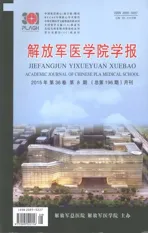脊柱畸形手术术中CT导航与徒手椎弓根置钉准确性比较
2015-03-21张永刚任宁涛董天祥
王 铀,崔 赓,张永刚,任宁涛,张 恒,齐 鹏,董天祥
解放军总医院 骨科,北京 100853
脊柱畸形手术术中CT导航与徒手椎弓根置钉准确性比较
王 铀,崔 赓,张永刚,任宁涛,张 恒,齐 鹏,董天祥
解放军总医院 骨科,北京 100853
目的通过与徒手置钉的比较,探讨在后路全椎弓根钉治疗脊柱畸形手术术中CT导航下置钉的准确性优势及临床价值。方法回顾性分析2009 - 2012年我科连续100例接受脊柱矫形手术并行术中CT的患者。所有病例分为导航组和非导航组,其中导航组37例,非导航组63例。根据椎弓根钉置入节段的不同,将两组各分为胸椎、上胸椎、中胸椎、下胸椎及腰椎5个亚组,比较并分析两组整体间及各亚组间椎弓根螺钉的置钉准确性。结果导航组总体椎弓根置钉准确率(94.61%)高于非导航组(88.43%)(P<0.05),返修率(2.43%)低于非导航组(6.06%)(P<0.05);各亚组间比较,导航胸椎组、中胸椎组、下胸椎组椎弓根置钉准确率均高于非导航相对应组(P<0.05),返修率均低于非导航相对应组(P<0.05);两组上胸椎组间及腰椎组间准确率及返修率差异均无统计学意义。结论术中CT导航可提高脊柱畸形矫形手术中的椎弓根螺钉置钉准确性,尤其是胸椎弓根置钉的准确性。
术中CT;导航;椎弓根螺钉;脊柱畸形
椎弓根螺钉内固定技术具有把持力强、椎体去旋转及矫形能力好、所需固定节段短、可实现三柱固定及冠状位平衡效果好等优点[1-4],近年来广泛用于脊柱畸形的外科治疗。然而,由于脊柱畸形患者不同椎体椎弓根尺寸及方向上存在较大的差异,椎弓根螺钉的置入存在一定的风险,如神经血管损伤、胸腹腔脏器损伤等[5-6]。随着各种计算机导航技术的发展,术中CT导航技术有明显优势,可为术者提供实时高清三维影像,能显著提高椎弓根螺钉置钉准确性[7-9]。本研究就脊柱畸形术中CT导航辅助下椎弓根置钉与徒手置钉准确性进行对比分析。
资料和方法
1 资料 回顾性分析2009 - 2012年于我院接受脊柱畸形矫形手术并行术中CT的连续100例患者,其中男性47例,女性53例。所有病例分为导航组和非导航组,其中导航组37例,非导航组63例;根据椎弓根钉置入节段的不同,将两组病例各分为5个亚组:胸椎组,上胸椎组(胸1 ~ 4),中胸椎组(胸5 ~ 8),下胸椎组(胸9 ~ 12)及腰椎组。见表1。
2 手术方法 两组病例手术均在CT手术室进行。1)导航组:采用气管插管全身麻醉后,患者取俯卧位,消毒后铺无菌巾单,按预定融合范围常规切开皮肤及皮下组织,显露后方骨性结构;将参考架固定于棘突上,而后行术中CT扫描。扫描结束后,采集的数据自动上传至导航中心。基于术中采集的数据,自动注册后,将生成冠状位、矢状位、横断位的实时三维影像,并可清晰显示导航器械或内置物与椎弓根壁及椎体的相对位置[10](图1)。在导航系统支持下,选择进钉点及钉道,各椎体置入椎弓根螺钉,且各椎弓根的直径及长度均可准确测量,因此术中可选择合适型号的椎弓根螺钉。2)非导航组:采取传统的徒手置钉技术。所有椎弓根钉置入完毕后,再次行术中CT扫描,并由有经验的脊柱外科医师评定各螺钉的准确性及记录螺钉破出程度,评定标准依据Ganesh Rao法[11]。若螺钉破出椎弓根壁>2 mm(gradeⅡ),则评定为误置螺钉,需重新置入;误置螺钉修正完毕后,再次行术中CT扫描直至所有螺钉评定合格,而后置入内固定棒并行畸形矫正。
3 统计学方法 采用SPSS16.0统计学分析软件,计量资料以表示,分类数据采用χ2检验,比较并分析两组的性别、年龄、置钉准确率及返修率,P<0.05为差异有统计学意义。
结 果
1 两组一般资料比较 导航组与非导航组间性别及年龄差异均无统计学意义;导航组37例共置入椎弓根钉575枚,非导航组63例共置入椎弓根钉1 072枚;导航组胸、腰椎置钉数分别为381枚和194枚,其中上胸椎67枚,中胸椎125枚,下胸椎189枚;非导航组胸、腰椎分别置钉752枚和320枚,其中上胸椎119枚,中胸椎249枚,下胸椎384枚。见表1。
2 两组置钉准确率比较 导航组总体椎弓根置钉准确率(94.61%)高于非导航组(88.43%)(P<0.05),返修率(2.43%)低于非导航组(6.06%)(P<0.05);与非导航组相比,导航组胸椎椎弓根置钉准确率(93.44%)明显更高(P=0.000 3),返修率(2.89%)更低(P=0.005 2);但两组间腰椎的置钉准确率(P=0.087 4)及返修率(P=0.111 3)均无统计学差异。胸椎各亚组间,相比于非导航组,导航组中胸椎及下胸椎组置钉准确率明显更高,返修率明显更低;但上胸椎组间置钉准确率及返修率均无统计学差异。见表1。

图 1 术中CT实时导航下椎弓根进钉点及进钉路径A:横断位术中CT影像;B:矢状位术中CT影像;C:冠状位术中CT影像;D:冠状位不同层面的术中CT影像 0 mm、5 mm、10 mm、15 mmFig. 1 Entry point and trajectory for pedicle screw insertion into deformed vertebra using the tracked pedicle awl in the real-time images of iCT based navigationA: Axial plane of iCT image guidance; B: sagittal plane of iCT image guidance; C: coronal plane of iCT image guidance; D: different levels (0 mm, 5 mm, 10 mm, and 15 mm) of coronal plane of iCT image guidance

表1 临床资料及临床数据分析结果Tab. 1 Demographic and clinical outcome data (n, %)
讨 论
由于具有比其他内固定技术更加优越的生物力学效应[1,12-13],脊柱椎弓根螺钉内固定术自出现开始就广泛应用于脊柱外科手术。然而,椎弓根螺钉的应用仍存在一定风险,如螺钉误置后导致脊髓损伤、神经根损伤、大血管损伤及胸、腹腔脏器损伤等,并因此引起沉重的社会经济负担[14-15]。
随着计算机导航技术的发展,椎弓根螺钉内固定技术治疗脊柱畸形的安全性已有所提高[9]。目前,主要的导航技术有如下几种:“C”型臂透视二维图像导航,CT术前图像导航,Iso-C术中三维导航,“O”臂术中三维导航,术中MRI导航及术中三维CT导航技术。与其他几种导航技术相比,术中三维CT导航技术具有诸多优势,如自动注册、注册时间短、采集数据快、实时导航、高清三维影像等[7-8,16-18]。
Tormenti等[17]报道,在术中三维CT导航技术辅助下,脊柱矫形手术共置入椎弓根钉164枚,误置2枚,螺钉误置率1.22%。本研究中,导航组胸椎螺钉破出率为6.6%,全脊柱螺钉破出率为5.3%,而在非导航组,此比例分别为13.7%和11.6%,并且导航组的误置返修率也明显低于非导航组;导航组螺钉误置率为2.43%,与Tormenti研究结果相近。若根据节段不同将胸椎分成3个亚组,结果表明,导航组中胸椎及下胸椎置钉准确性明显高于非导航组,但是上胸椎及腰椎两组间无明显统计学差异,我们推测原因在于上胸椎畸形相对较轻、样本数量较少,而腰椎椎弓根直径较宽,螺钉置入相对简单。脊柱畸形患者不同椎弓根间形态学差异较大,且普遍存在椎体旋转,这种椎体旋转通常出现在三维角度而不仅是单平面上,Liljenqvist等[19]报道椎体旋转与凹侧椎弓根直径之间存在明显负相关关系,这也是脊柱畸形椎弓根钉容易出现误置并导致相关风险产生的原因之一[20]。因此,术中三维CT导航技术的应用理论上有利于提高置钉安全性,因为它可以在三维角度清晰地呈现导航器械或内置物与椎弓根壁及椎体的相对位置。所以,我们认为此技术可以有效提高脊柱矫形手术,尤其是重度畸形矫形术的置钉准确性。然而,术中CT导航有其局限性,这些缺点使其难以得到普及,如价格昂贵、学习曲线长,另外,尽管避免了工作人员的射线暴露,但增加了患者的射线吸收剂量,同时也加重了患者的经济负担[9]。
术中三维CT导航技术应用于脊柱畸形的外科治疗,尤其在胸椎置钉时,可明显提高椎弓根螺钉置入的准确性,降低螺钉误置率,减少手术并发症的发生。
参考文献
1 Gaines RW. The use of pedicle-screw internal fixation for the operative treatment of spinal disorders[J]. J Bone Joint Surg Am,2000, 82A(10): 1458-1476.
2 Lee SM, Suk SI, Chung ER. Direct vertebral rotation: a new technique of three-dimensional deformity correction with segmental pedicle screw fixation in adolescent idiopathic scoliosis[J]. Spine(Phila Pa 1976), 2004, 29(3):343-349.
3 Bridwell KH. Surgical treatment of idiopathic adolescent scoliosis[J]. Spine (Phila Pa 1976), 1999, 24(24):2607-2616.
4 Kim YJ, Lenke LG, Cho SK, et al. Comparative analysis of pedicle screw versus hook instrumentation in posterior spinal fusion of adolescent idiopathic scoliosis[J]. Spine (Phila Pa 1976), 2004,29(18): 2040-2048.
5 Di Silvestre M, Parisini P, Lolli FA. Complications of thoracic pedicle screws in scoliosis treatment[J]. Spine (Phila Pa 1976), 2007, 32(15): 1655-1661.
6 Diab M, Smith AR, Kuklo TR, et al. Neural complications in the surgical treatment of adolescent idiopathic scoliosis[J]. Spine (Phila Pa 1976), 2007, 32(24): 2759-2763.
7 Scheufler KM, Cyron D, Dohmen HA. Less invasive surgical correction of adult degenerative scoliosis, part I: technique and radiographic results[J]. Neurosurgery, 2010, 67(3): 696-710.
8 Scheufler KM, Cyron D, Dohmen HA. Less invasive surgical correction of adult degenerative scoliosis. part II: complications and clinical outcome[J]. Neurosurgery, 2010, 67(6): 1609-1621.
9 Cui G, Wang Y, Kao TH, et al. Application of intraoperative computed tomography with or without navigation system in surgical correction of spinal deformity a preliminary result of 59 consecutive human cases[J]. Spine (Phila Pa 1976), 2012, 37(10): 891-900.
10 Amiot LP, Lang K, Putzier M, et al. Comparative results between conventional and computer-assisted pedicle screw installation in the thoracic, lumbar, and sacral spine[J]. Spine (Phila Pa 1976),2000, 25(5): 606-614.
11 Rao G, Brodke DS, Rondina M, et al. Inter- and intraobserver reliability of computed tomography in assessment of thoracic pedicle screw placement[J]. Spine (Phila Pa 1976), 2003, 28(22):2527-2530.
12 Belmont PJ, Klemme WR, Dhawan A, et al. In vivo accuracy of thoracic pedicle screws[J]. Spine (Phila Pa 1976), 2001, 26(21):2340-2346.
13 O’brien MF, Lenke LG, Mardjetko S, et al. Pedicle morphology in thoracic adolescent idiopathic scoliosis - Is pedicle fixation an anatomically viable technique?[J]. Spine (Phila Pa 1976), 2000,25(18): 2285-2293.
14 Kotani Y, Abumi K, Ito M, et al. Accuracy analysis of pedicle screw placement in posterior scoliosis surgery - Comparison between conventional fluoroscopic and computer-assisted technique[J]. Spine (Phila Pa 1976), 2007, 32(14): 1543-1550.
15 Lonstein JE, Denis F, Perra JH, et al. Complications associated with pedicle screws[J]. J Bone Joint Surg Am, 1999, 81(11):1519-1528.
16 Haberland N, Ebmeier K, Grunewald JP, et al. Incorporation of intraoperative computerized tomography in a newly developed spinal navigation technique[J]. Comput Aided Surg, 2000, 5(1):18-27.
17 Tormenti MJ, Kostov DB, Gardner PA, et al. Intraoperative computed tomography image-guided navigation for posterior thoracolumbar spinal instrumentation in spinal deformity surgery[J]. Neurosurg Focus, 2010, 28(3): E11.
18 Uhl E, Zausinger S, Morhard D, et al. Intraoperative computed tomography with integrated navigation system in a multidisciplinary operating suite[J]. Neurosurgery, 2009, 64(5S2):231-239.
19 Liljenqvist UR, Link TM, Halm HF. Morphometric analysis of thoracic and lumbar vertebrae in idiopathic scoliosis[J]. Spine (Phila Pa 1976), 2000, 25(10): 1247-1253.
20 Tian W, Lang Z. Placement of pedicle screws using three-dimensional fluoroscopy-based navigation in lumbar vertebrae with axial rotation[J]. Eur Spine J, 2010, 19(11): 1928-1935.
Comparison of intraoperative CT – based navigation versus non-navigated pedicle screw placement in surgical correction of spinal deformity
WANG You, CUI Geng, ZHANG Yonggang, REN Ningtao, ZHANG Heng, QI Peng, DONG Tianxiang
Department of Orthopaedic, Chinese PLA General Hospital, Beijing 100853, China
CUI Geng. Email: cuigeng@aliyun.com
ObjectiveTo explore the results and clinical value of intraoperative computed tomography (iCT) navigation in pedicle screw insertion accuracy in comparison to screw placement without navigation in spinal deformity surgery.MethodsClinical data about 100 patients who underwent surgical deformity correction with assistance of iCT in our hospital from 2009 to 2012 were retrospectively analyzed. All patients were divided into two groups: navigation group (n=37), and non-navigation group (n=63). In each group, patients were divided into different subgroups according to the spinal segment (thoracic vertebrae, upper/middle/ lower thoracic vertebrae, lumbar vertebrae). The screw placement accuracy was analyzed.ResultsCompared with non-navigation group, there showed a higher accuracy rate and a lower revision rate of total pedicle screws placement in navigation group (94.61% vs 88.43%, 2.43% vs 6.06%, P<0.05). The screws insertion accuracy rate of thoracic pedicle screws, middle and lower thoracic screws in navigation group was higher and the revision rate was lower than that of non-navigation group. However, no significant difference was found in upper thoracic and lumbar pedicle screws (P<0.05).ConclusionThe iCT navigation system provides a high accuracy of pedicle screw placement in surgical correction of spinal deformity, especially in thoracic spinal instrumentation.
intraoperative CT; navigation; pedicle screws; spinal deformity
R 687.3
A
2095-5227(2015)06-0595-04
10.3969/j.issn.2095-5227.2015.06.020
时间:2015-03-10 09:44
http://www.cnki.net/kcms/detail/11.3275.R.20150310.0944.005.html
2014-12-16
王铀,男,在读硕士,医师。研究方向:脊柱外科。Email: magicwangyou@163.com
崔庚,男,博士,副主任医师,硕士生导师。Email: cuigeng@aliyun.com
